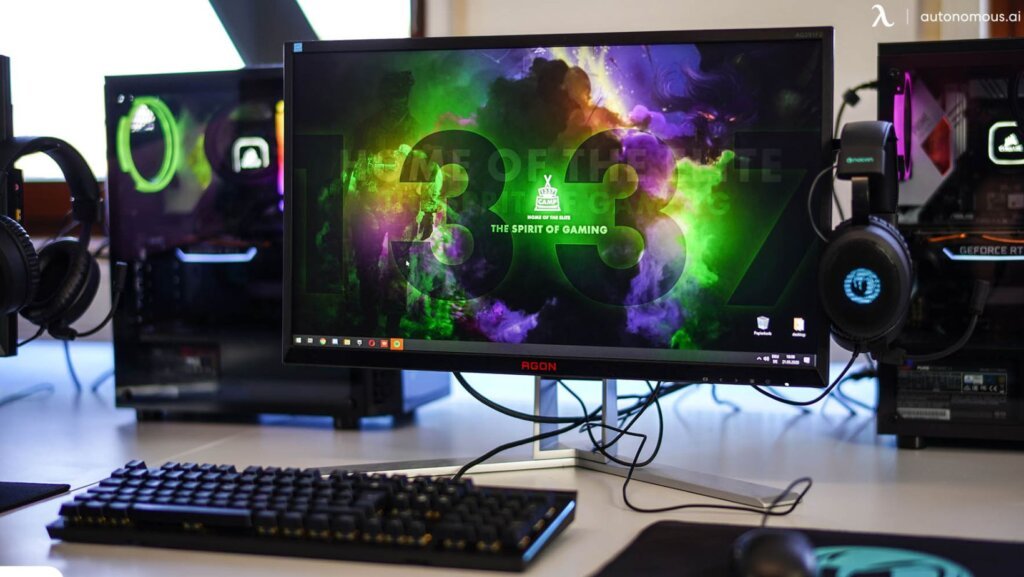A dual PC audio system can significantly improve your streaming or gaming experience. This setup is best for people who want to keep game sound separate from communication sound, allowing for better immersion and more precise chats with teammates or viewers.
Using an Ethernet cable for this setup helps transmit audio. It provides high-quality sound with almost no delay, essential for gamers and streamers who need real-time audio. Ethernet also reduces the chance of interference with regular audio cables, which can affect sound quality.
This guide will explain the benefits of a dual PC audio setup using Ethernet, like better sound and less lag. We’ll cover important parts of the setup, such as audio interfaces and mixers, and provide step-by-step instructions for configuring your systems.
We’ll also include common troubleshooting tips to help you fix any issues. By the end of this guide, you’ll have the knowledge and tools to enhance your audio experience in gaming or streaming.
Why Use a Dual PC Audio Setup?
One PC usually stays only for gaming and the other for streaming or audio processing. The separation can help reduce the gaming PC load, improving performance. Some benefits of the audio setup using a dual PC include the following benefits:
Improved Performance: Offloading audio processing to another PC ensures that certain resources are released from your gaming rig, allowing you to play more smoothly and maintain larger frame rates.
Better Audio Quality: A dedicated audio interface on the PC can improve sound quality, making the audio much more straightforward for your audience.
Flexibility: Audio settings can be customized independently on each PC, allowing for unique audio experiences in playing and streaming.
Reduced Latency: Transmission of audio over Ethernet can reduce latency problems and ensure that audio perfectly syncs with the gameplay.
You will thus need the following to install a dual PC audio system that sends audio over Ethernet:
Two PCs: In this case, one should be for gaming and the other for streaming. These PCs must possess adequate processing power and RAM to be efficient enough for their respective jobs.
Audio Interface: A high-grade audio interface used in the streaming PC. It will be able to capture and process the respective audio signals accordingly.
Ethernet Cable: Use Cat5e or Cat6 to ensure audio transmissions are carried out securely. Such cables support good data transfer rates, which are essential for quality audio.
Audio Software: Voicemeeter, OBS, and other audio routing software. These applications will facilitate arranging inputs and outputs.
Network Switch (optional): You may need to connect several devices or PCs, and a network switch can help organize your connections.
Setting Up The Dual PC Audio System
These are the steps to set up your Dual PC Audio Setup audio system:
Step 1: Connecting the PCs
Connect the PCs via Ethernet: Use an Ethernet cable to connect both PCs directly or through a network switch. If using a switch, ensure that it is powered and working correctly.
Configure Network Settings: The two PCs must be on the same network and talking to each other. You might have to assign static IP addresses to both PCs.
Step 2: Audio Software Installation
Install Voicemeeter: This software efficiently manages audio inputs and outputs. You must download and install it on your live-streaming PC.
Configure Voicemeeter: Connect Voicemeeter to your gaming PC and send audio to your streaming software. Voicemeeter has a virtual audio mixer that can support multichannel audio.
Step 3: Audio Routing Configuration
Configure Audio Sources: From the gaming PC, use the machine to alter the audio output to send audio through to the Voicemeeter virtual input. Most modern operating systems have this type of function under sound settings.
Configure the Voicemeeter settings on the streaming Dual PC so that Voicemeeter will capture the correct audio source. In this case, you can configure Voicemeeter to capture two different outputs: your headphones and your streaming software.
Step 4: Testing
Test Stream: Start a test stream from the gaming PC to the streaming PC by sending audio and testing the transmission. Start testing the audio transmission from the gaming PC to the streaming PC for cases of audio dropouts and latency problems.
Audio Levels Monitoring: Use Voicemeeter’s audio monitoring features to check and adjust levels appropriately. Balance all audio levels to avoid distortion or clipping.
Configuring Voicemeeter In Granular Detail
Voicemeeter is one of the most powerful tools for configuring your setup. Here’s how to use it.
Input Configuration
Virtual Inputs: Set up virtual inputs inside Voicemeeter, through which you will receive audio from your gaming PC. The virtual input should be set as the default playback device in your gaming PC.
Physical Inputs: If you have connected a microphone to your streaming PC, set it up as a physical input inside Voicemeeter. This will enable the mixing of voice with the game audio.
Output Configuration
Headphones: In Voicemeeter, set your headphones as one of the outputs. Then, you can monitor audio in real-time.
Software Streaming: Configure the output for your software streaming application, like OBS, so that Voicemeeter takes audio. Now, your audience hears what’s mixed through Voicemeeter.
Advanced Features
Equalization Voicemeeter also includes equalization settings. This can enhance the response frequency of the audio, clear out voice, or even block out background noise.
Compression: By compressing your audio, you will stabilize the levels so that distortion is eradicated from your voice when the moments get loud.
Smooth Performance Tips
Use these tips as you progress to ensure smooth audio recordings without affecting your gameplay performances.
Use Quality Ethernet Cables: Use quality Ethernet cables to reduce latency and interference. Cat6 is recommended because of its higher bandwidth capability.
Audio software and driver maintenance: Regularly update your audio software and drivers to ensure compatibility and proper performance. This includes Voicemeeter, your audio interface drivers, or any streaming software you use.
Monitor Network Traffic: Is your audio dropping? Monitor network traffic and see if an application is taking more bandwidth than necessary. Shut down unnecessary applications that are competing with your audio.
Try different buffer sizes at this step, but choose a small one. This will help you balance low latency and high-quality audio in Voicemeeter. The smaller the buffer size, the lower the latency, but this comes with more risks of dropouts, as the audio signals can be lost during that buffer period.
Some Common Challenges That May Persist in Your
Audio While Transmitting:
Issues can still arise even with the best configurations set for dual PC audio. Just a few common problems and resolutions are shown as follows:
Low Frame Rates During Recording
In case low frame rates appear during recording, follow these steps;
Reduce Recording Resolution: If the gaming PC cannot handle high resolutions, the recording resolution or frame rate may need to be reduced.
Check that the GPU drivers are up-to-date and install all the latest updates. If left to update on their own, they can often cause a massive hit in performance.
Pre-game: Shut Down Background Applications. Always shut down any background applications using system resources before you launch your game. This includes web browsers, streaming services, and any other background processes.
Audio Latency: If you experience latency, adjust your Voicemeeter settings to a lower latency setting. A smaller buffer size lowers latency but increases the chances of audio dropouts.
No Audio Output: If Shadowplay does not record, follow these steps:
Ensure the In-Game Overlay Is Enabled: Check both PCs for the settings that will enable it.
Check Your Audio Output Device: Ensure that the correct output device has been selected on both PCs. Sometimes, this defaults when the PC automatically updates or even after a restart.
Restart Voicemeeter: If you’re experiencing glitches, restarting Voicemeeter might help you remove temporary bugs.
Audio Desynchronization: If your video is not in sync with the audio, check this:
Ensure that your audio is correctly set up in Voicemeeter so no delays are applied on any of the inputs.
Video editing software: Use video editing software to manually sync up the audio you have if you are noticing consistent desync
Advanced Settings For Power Users
Nvidia Shadowplay has advanced settings so that you can customize as much as possible.
1. Custom Bitrate Control: If you want to control your recordings, try using custom bitrate settings. You can balance the quality of the recordings and minimize the file size according to your specifications. Higher bitrates result in better quality, but they also mean larger file sizes.
2. Variable Frame Rate: It helps users maintain a high recording quality even in expensive systems while experiencing intense gaming. It dynamically varies the frame rate concerning the scene’s complexity.
3. Use external tools: External tools, especially OBS Studio for complex recording and streaming, may be used instead. While Voicemeeter is excellent for audio routing and severe content creation, the flexibility that OBS may offer with professional scenarios of scene management, additional audio sources, and so on is needed.
Conclusion: Dual PC Audio Setup
A Dual PC Audio Setup that transfers audio over Ethernet will take your gaming and streaming to another level. With the step-by-step process explained in this article, you’ll be able to have a high-quality audio setup to achieve better performance and flexibility. You will then be set up with proper components and configurations to create a professional audio environment for your content creation.
FAQs- Dual PC Audio Setup
What’s a Dual PC Audio Setup?
This would mean that one will be playing the game on one computer and doing audio streaming or audio processing on another. By separating the computers, performance improves by allowing a computer to process audio on another computer to play the game at smoother frame rates.
Why Should I Use Ethernet For Audio Transmission?
Audio streaming over Ethernet provides high-quality, low-latency audio. This is good for gamers and streamers whose audio should perfectly sync with the game action.
What If I Experience Latency On My Audio?
Adjust the Voicemeeter buffer setting again. Reducing the buffer size would easily deter latency but at the risk of dropping out audio.







